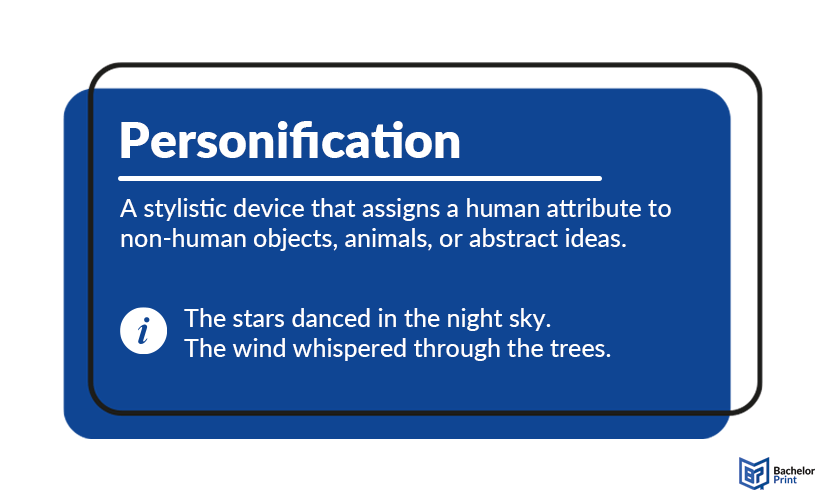
In many stories, you will read how the light was dancing on the water’s surface or how the wind was howling outside. These vivid images are created by attributing human characteristics or actions to non-human entities. The name for this type of figurative language is personification and although it is rarely used in academic writing, it can still be helpful, especially in a literary analysis. The following article will cover all relevant information about personification and explain it through various examples.
Definition: Personification
When a non-human thing, such as an animal, object, or even an idea, gets attributed with human qualities, it is called a personification. The object is personified because it acts in a way only a human could, or because it is assigned with a human trait. Through this, the reader can easily empathize with non-human characters and inanimate objects.

- ✓ Free express delivery
- ✓ Individual embossing
- ✓ Selection of high-quality bindings
Use and purpose
Personifications are used to engage the reader in the story. They compare the action of an object or animal to a human one, creating a vivid image in the minds of the people. Personified entities can also be used to describe how a human character perceives their surroundings, positively or negatively. For example, if the sun “kissed” her skin, it is positively connotated, while if the sun “glared” down at her, the connotation is negative.
Furthermore, this stylistic device can also simplify certain concepts and make them easier to explain. An example of this would be the “bees and flowers” explanation, which uses a metaphor as well as a personification to make the concept understandable to small children.
History
Personification as such has existed as long as human storytelling has existed because we see the world from a human perspective, and it is thus easier for us to describe things in the same way. The origin of this stylistic device lies in an ancient Athenian orator named Demetrius of Phalerum, who called it “prosopopoeia.” Later, the name was changed to “personification” to simplify it.
Personification vs. anthropomorphism
A stylistic device that often gets confused with personification is anthropomorphism. While the former assigns a human attribute to a non-human character, the latter makes the non-human character become a distinct character. The key difference is that the former one merely compares the actions of non-humans to human ones, while anthropomorphism actually creates a human-like character with physical and mental capabilities. This is typically the case in fables or fairytales, where animals behave and act like humans.
Personification
Anthropomorphism
Personification: Examples
As it is mostly used in creative writing or narrative writing, here are some examples of personification in figurative language and literary context and music.
in Your Thesis
FAQs
A personification is the attribution of a human characteristic to a non-human entity. For example, “the sun was smiling from the sky.”
To create one, you first need to decide what you want to express, and then select the noun and a fitting verb or adjective that describes the action in a humanized way. For example, “the light was dancing on the surface of the river.” The noun “light” is attributed to the verb “dancing”, which is normally only a human capability.
This depends on the different situations. Generally, animals in fairytales can speak and behave like human beings, which classifies them as an anthropomorphism instead of a personification. Personified objects or animals are only attributed with human characteristics that compare their actions to human ones. An anthropomorphism creates a whole new human-like character from the non-human entity.
Some examples can be:
- The sun is smiling down at the earth.
- The wind is whispering in the trees.
- The rain was knocking on my window.
- My alarm screamed to wake me up.
- New York is a city that never sleeps.
